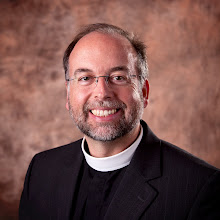Thursday, May 3, 2012
Let's Get Physical
Tuesday, April 10, 2012
We've Already Heard this Story
Tell Me the Truth
He Saves Others
Wednesday, March 28, 2012
Holy Week Nostalgia
In my home growing up, life had a different rhythm during Holy Week. It was a part of our family rhythm to be in church on Palm Sunday, Maundy Thursday, Good Friday and Easter. As a family, we experienced together, each and every year, the wonderful mystery of the death and resurrection of Jesus.
Many people get nostalgic at Christmas, remembering Christmases past with loved ones. Yet as I get older, I get nostalgic about Holy Week, remembering Holy Weeks past with loved ones.
When I was a child and a teenager, we went to our own church for the worship services during Holy Week. Yet on Good Friday, we always went to the church of my grandparents: St. John the Divine Episcopal Church in Houston. This was also the church where I was baptized – and where I would later be married.
At St. John the Divine, the Good Friday worship service lasted from 12:00 PM to 3:00 PM, the same hours that Jesus hung on the cross. However, the service was “come and go” so that you could stay for as long as you wanted during the three hours. A hymn was sung every 20 minutes, so that people could come and go during the singing.
Each year on Good Friday, we would pick up my grandmother for a simple lunch. After lunch, we drove to Glenwood Cemetery, where many of my ancestors are buried. At the cemetery, we would reverently place a few Easter lilies on the graves. After a moment of hushed remembrance and the quiet re-telling of the stories of the dead, we would depart for church, arriving a little before 2 o’clock. At 3 o’clock, the hour that Jesus died, the big bell in the tower tolled. In that silent church, with only the sound of a lone bell, my grandmother would sniffle, fighting back tears as she remembered those who had experienced their own Good Fridays.
Remembering is a large part of our faith story. In fact we could say that the whole of the Scriptures are read and digested, daily and weekly, so that we can remember the mighty deeds of God. At the Last Supper, Jesus takes bread and says: “Do this in remembrance of me.” He takes the cup of wine and says: “Do this in remembrance of me.” Each Sunday in the Eucharist, we remember the death and resurrection of Jesus.
During Holy Week – and especially on Good Friday – I get nostalgic and I remember. I remember my ancestors who are dead and buried, who died in the hope of the resurrection. I remember kneeling with my family, hearing the bell toll at 3 o’clock, the hour of Jesus’ death. I remember the sound of my grandmother, sniffling back her tears.
This Holy Week and Easter, I invite you to take up the rhythm of this week. Make it different than all other weeks. Make memories for yourself and for your descendents. Make this Holy Week - a time to remember.
The Judgment of this World
Thursday, January 5, 2012
Can I Be Baptized?
Can I be baptized?
In an age where many people are not baptized as infants, I receive this question often from adults who have not been baptized. Some hesitance in the asking of this question usually involves follow-up questions such as: What if I don’t think I am ready to be baptized? What if I am not good enough or educated enough?
Our Holy Scriptures give us, especially in the Book of Acts, examples of baptisms in the early Church. In no instance is someone told to wait on being baptized because they aren’t ready or they aren’t good enough or they don’t have a seminary education to explain the theology of baptism. In all instances, baptism is presented in the Book of Acts as a gift, a gift of the Holy Spirit that propels us to do the work of Jesus in the world.
Beginning on Monday, January 16, St. Alban’s will enter into a 5 week exploration of the Book of Acts. You will have 3 opportunities each week to attend a session. These sessions will be augmented by Adult & Youth Sunday School each week.
I invite you to enter into the fullness of your baptism by exploring the Book of Acts. I invite you to discover that you are never ready enough or smart enough or good enough to receive the free gift of God’s Holy Spirit.
